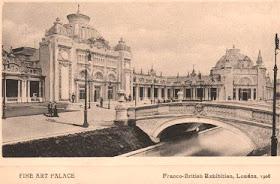This miraculous achievement was, by itself, enough reason for a World Exhibition, along the lines of those held in London in 1851, Paris in 1855, Vienna in 1873, Sydney and Melbourne in 1879/1880, Chicago in 1893 and St Louis in 1904. But London was also about to stage the Olympic Games during the summer of 1908, a perfect time for attracting large crowds to the British capital. The project, the first-ever World Exhibition organised and sponsored by two separate nations, was held in an area of West London near Shepherd's Bush.
Even the local infrastructure was improved. Situated between Shepherd's Bush and White City, Wood Lane railway station was newly opened, specifically to serve the 1908 Franco-British exhibition. Railway buffs noted that there was an elevated enclosed walkway running from Shepherd's Bush, leading to several exhibition halls that were raised off the ground on stilts.
The Franco-British Exhibition of 1908
Eight million visitors walked through the turnstiles! They had a wonderful time, inspecting 140 acres of fairground land that included an artificial lake, surrounded by an immense network of white buildings in ornate, Orientalist architecture. In the Fine Arts Palace, British and French artists displayed the most modern paintings, by past and by living stars. Furniture and other decorative arts were stunning, commercial studio pottery was hugely popular and wall tiles charmed the viewers.
Court of Honour, Franco-British Exhibition (above)
Fine Art Palace, Franco-British Exhibition (below)
For fantastic images from the 1908 World Exhibition, see Vintage Postcards and Postcards of the Past.
Did French visitors travel across the Channel in large numbers and were they as committed to the joint exhibition as the British were? A French reviewer wrote his immediate impressions. In his opinion, the most important of the pavilions, and in fact the only two that were really tasteful, were the Pavilion of the City of Paris and the rather florid Collectivite Delieux in the Art Nouveau style. The Pavilion of the City of Paris was a blend of well-known examples of Gothic and French Renaissance, refined and graceful in its details, that gave visitors the reposeful pleasure always attending the contemplation of a pure work of art. Of course he would write that :)
The long term results of the 1908 Exhibition were felt on both sides of the Channel. For the centenary of the Franco-British Exhibition and the 1908 Olympic Games, a conference was devoted to Arts and Culture at the Turn of Century, organised by members of the Franco-British Network in partnership with their respective universities. In addition to the Exhibition and the Olympics, the emergence of new literary and artistic trends, the maturing of the industrial society in the modern city, as well as the importance of colonisation for these two countries, fully justified the scholarship. The main question was how did the artistic and cultural transformations take place in Edwardian France and Britain, taking into account the cultural exchanges, and the economic, technical and scientific factors then.
Marianne, a national emblem of France, and John Bull, a national personification of Great Britain, get it together.
A very useful booklet has been Great Exhibitions: The World Fairs 1851-1937, written by Robert Wilson and published by National Gallery of Victoria in 2008. Also you might find Franco-British Exhibition: Official souvenir, London, 1908: Sp Coll RB 1445




Australia had an interest in this world fair. All countries had their own pavilion, including Australia, but we also had Dame Nellie Melba singing up a storm.
ReplyDeleteGreat post and images. One of the events I would love to invent a time machine for.
ReplyDeleteartlover
ReplyDeleteand one more thing. Percy Marks, a Sydney jeweller, won the grand prix at the 1908 Franco-British Exhibition for his amazing black opals.
Hermes
ReplyDeletethe Edwardian era must have been very tough for half the population,
but in some ways it was a totally exciting period of technology, culture and scientific progress. Nothing expressed this excitement better than a world exhibition. I too would loved to have been there.
Excellent post. As Hermes said, it would be wonderful to be able to travel back and visit the exhibtion. But the Entente Cordiale did have a dark side. It was negotiated two years after Britain had ended her splendid isolation by signing a military treaty with Japan, and it was followed by an entente with Russia just the year before this exhibition took place. The fact that France and Russia already had a military treaty since 1894, and now both had agreements with Britain, convinced the German Chiefs of Staff that they were being completely encircled by an "Einkreisingungspolitik". The German leadership felt they had to burst out of this hostile circle of Britain, France and Russia. The opportunity arose in the summer of 1914, with awful consequences.
ReplyDeletePM Doolan
ReplyDeleteI appreciate the true background to the Entente cordiale because the reason for the grand celebration in 1908 was military-political and not commercial-cultural.
But in any case, I wonder if visitors to the Franco-British Exhibition were aware of the Entente cordiale of 1904.
Firstly four years had passed and the connection might have slipped the public's mind. Secondly from what we can see from the posters, catalogues and souvenirs, the connection between Britain and France looked misty, romantic and historical. Not a political or military man in sight.